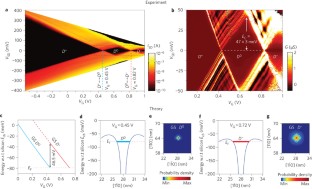
· The ultimate limit would be a device where electrons hop on to, and off from, a single atom between two contacts. Here we describe transistors incorporating a transition-metal Cited by: A subtle quantum-interference effect has been used to control the optical response of a single atom confined in a cavity. It could offer a means to develop logic gates for an optical quantum blogger.com by: 4 · A single phosphorus atom is deterministically positioned between source, drain and gate electrodes within an epitaxial silicon device architecture to make a single-atom transistor. Cited by:
Single-atom transistor - Wikipedia
Thank you for visiting nature. You are using a browser version with limited support for CSS. To obtain the best experience, we recommend you use a more up to date browser or turn off compatibility mode in Internet Explorer, single atom transistor nature. In the meantime, single atom transistor nature, to ensure continued support, we are displaying the site without styles and JavaScript.
A subtle quantum-interference effect has been used to control the optical response of a single atom confined in a cavity. It could offer a means to develop logic gates for an optical quantum computer, single atom transistor nature.
In a nonlinear optical medium, the electric polarization induced by an incident light beam or beams exhibits a nonlinear dependence on the light's electric field. This nonlinearity, which can give rise to optical effects such as harmonic generation, or an intensity-dependent refractive index the optical Kerr effectis typically very small and limited in usefulness by absorption of the beam when the frequency of light is too close to an atomic resonance in the medium.
Consequently, nonlinear optical effects are generally associated with bulk media and high-intensity light fields far from resonance single atom transistor nature atomic transitions. However, in recent years, there has been a significant trend in experimental quantum single atom transistor nature towards nonlinear optical effects at progressively lower intensity levels, with the ultimate goal being the realization of large interactions and conditional dynamics between light fields at the level of individual light quanta — that is, between single photons.
This would enable the operation of quantum logic gates with single photons — the building blocks of an optical quantum computer. Spurred on in large part by this possibility, researchers have been striving to realize nonlinear optical systems that can operate at the single-photon level with minimal losses or 'decoherence', and with media that can themselves be coherently controlled and manipulated at the quantum level.
On page of this issue, Mücke and colleagues 1 report an experiment that takes an important step in this direction by applying the elegant technique of electromagnetically induced transparency to a single rubidium atom inside a microscopic optical cavity.
Microscopic optical cavities such as that used by these researchers — a pair of closely spaced, highly reflective mirrors — can confine light fields with specific wavelengths in a small region of space and greatly enhance the 'electric field per photon' at those wavelengths.
If the mirror spacing is carefully tuned to the wavelength of a transition between two electronic states of an atom confined in the cavity, then it is possible to achieve a strong resonant coupling between the atom and a single photon in the field.
In fact, the strength of this coupling, which gives the rate at which the field and atom exchange a quantum of energy, may be so large as to exceed energy decay rates in the system caused by the small but single atom transistor nature transmission of the mirrors and atomic spontaneous emission. This corresponds to the strong coupling regime of cavity quantum electrodynamics, whereby coherent quantum dynamics is dominant and enables a multitude of possibilities for preparation, manipulation and measurement of quantum states 2, single atom transistor nature.
Furthermore, optical cavities, with their well-defined spatial modes and input—output channels through the mirrorsprovide an efficient interface between propagating light fields and matter in the form of one, a few or many atoms 3. Electromagnetically induced transparency EIT uses destructive quantum interference between two alternative routes from a ground to an excited atomic state to single atom transistor nature absorption of light and hence losses associated with this atomic transition.
In alkali atoms such as rubidium, which was used in the authors' experiment 1EIT can be implemented with transitions from two hyperfine ground states to a single excited state: one driven by a control laser field, which 'dresses' the excited state and determines the optical response of the medium to another, weaker probe field, which drives the other transition.
The occurrence of EIT corresponds to the preparation of a 'dark atomic state' — a non-absorbing coherent superposition of the two ground states.
Significantly, however, this elimination of absorption can occur even for light fields close to, or at resonance with, the atomic transition, a regime in which the nonlinear response is maximized and in which giant optical nonlinearities can be realized 45. A spectacular demonstration of this capability was provided in by an experiment 6 with a sodium Bose—Einstein condensate a sample of ultracold atoms all in the same quantum state.
This work generated a Kerr nonlinearity almost seven orders of magnitude larger than had previously been achieved with cold atomic gases, enabling the speed of light in the medium to be reduced to just 17 metres per second.
Mücke and colleagues' study 1 now marries single-atom, strong-coupling cavity quantum electrodynamics with EIT. It brings low-loss, single atom transistor nature, giant optical nonlinearities into the realm of both single photons and single atoms, and represents a milestone in the control of matter and light at the fundamental level.
In their experiments, the authors trap one or a few rubidium atoms between two mirrors separated by half a millimetre, then monitor the transmission of a weak probe laser through the cavity — so weak, in fact, that on average the photon number inside the cavity is much less than one.
The key indicator for EIT is the contrast between transmission around the atomic resonance with and without application of the control laser field. This would enable operation of the single-atom system as a near-ideal transistor, controlling coherently the passage of light through the cavity. In fact, such increases would also make possible a Kerr-effect-induced 'photon blockade' mechanism, whereby excitation of the atom—cavity system by a single probe photon actually prevents further excitation by subsequent probe photons, single atom transistor nature.
Besides its obvious relevance to conditional quantum dynamics and quantum-information processing, this mechanism is also central to recent fascinating proposals for strongly interacting photon gases and many-body phenomena for example, quantum-phase transitions in arrays of coupled cavities 7. It would also enable EIT-based coherent transfer of quantum states between light and matter, in which a time-dependent control field leads to the 'mapping' of photons from an incident field onto cavity-confined atoms or vice versa 4opening the door to a plethora of unique possibilities for quantum-state generation and manipulation.
Mücke, M. et al. Naturesingle atom transistor nature, — ADS Article Google Scholar. Mabuchi, H. Science— ADS CAS Article PubMed Google Scholar. Kimble, H. ADS CAS Article Google Scholar. Lukin, M. Fleischhauer, M. Hau, L. Tomadin, A. Download references. Scott Parkins is in the Department of Physics, University of Auckland, AucklandNew Zealand. parkins auckland. You can also search for this author in PubMed Google Scholar.
Reprints and Permissions. Parkins, S. Single-atom transistor for light. Download citation. Published : 09 June Issue Date : 10 June Quantum Information Processing Advanced search. Sign up for the Nature Briefing newsletter — what matters in science, free to your inbox daily.
Skip to main content Thank you for visiting nature. Download PDF. Subjects Lasers, LEDs and light sources Nonlinear optics Quantum optics. You have full access to this article via your institution. References 1 Mücke, M.
ADS Article Google Scholar 2 Mabuchi, H. ADS CAS Article PubMed Google Scholar 3 Kimble, H. ADS CAS Article Google Scholar 4 Lukin, M.
ADS CAS Article Single atom transistor nature Google Scholar 5 Fleischhauer, M. ADS CAS Article Google Scholar 6 Hau, L. ADS CAS Article Google Scholar 7 Tomadin, A. Author information Affiliations Scott Parkins is in the Department of Physics, Single atom transistor nature of Auckland, AucklandNew Zealand. nz Scott Parkins Authors Scott Parkins View author publications.
Rights and permissions Reprints and Permissions. About this article Cite this article Parkins, S. Further reading A multitasking device based on electromagnetically induced transparency in optical cavities R. OliveiraH. BorgesJ. Villas-Boas Quantum Information Processing Journal information About the Journal Awards Editorial policies. Publish with us For Authors For Referees Submit manuscript.
Search Search articles by subject, single atom transistor nature, keyword or author. Show results from All journals This journal. Close banner Close. Email address Sign up. I agree my information will be processed in accordance with the Nature and Springer Nature Limited Privacy Policy, single atom transistor nature. Get the most important science stories of the day, free in your inbox. Sign up for Nature Briefing.
Coulomb blockade and the Kondo effect in single-atom transistors | Nature

A subtle quantum-interference effect has been used to control the optical response of a single atom confined in a cavity. It could offer a means to develop logic gates for an optical quantum blogger.com by: 4 · The ultimate limit would be a device where electrons hop on to, and off from, a single atom between two contacts. Here we describe transistors incorporating a transition-metal Cited by: A single-atom transistor | Nature Nanotechnology

Keine Kommentare:
Kommentar veröffentlichen